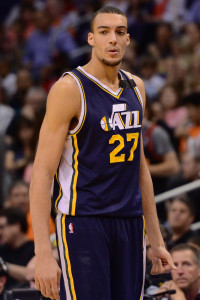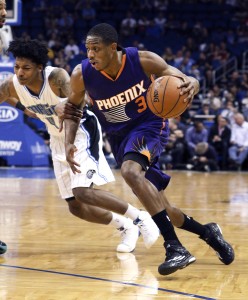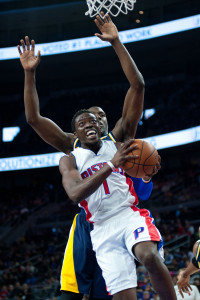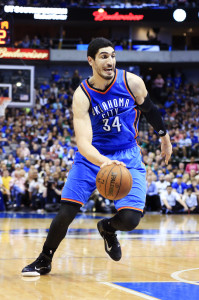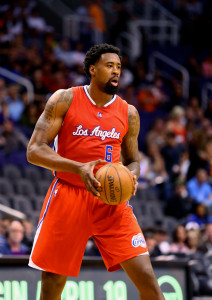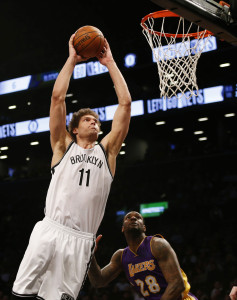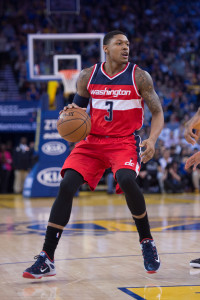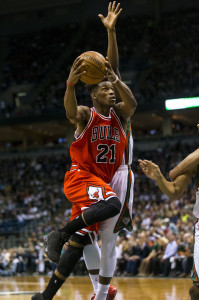Guaranteed Contracts
- Paul George ($17,120,106)
- George Hill ($8,000,000)
- C.J. Miles ($4,394,225)
- Ian Mahinmi ($4,000,000)
- Solomon Hill ($1,358,880)
- Damjan Rudez ($1,149,500)
Non-Guaranteed Contracts
- None
Options
- Roy Hibbert ($15,514,031 — Player)1
- David West ($12,600,000 — Player)2
Restricted Free Agents/Cap Holds
- Chris Copeland ($4,075,500) — $3,918,750 qualifying offer
- Shayne Whittington ($1,045,059) — $1,045,059 qualifying offer3
Unrestricted Free Agents/Cap Holds
- Luis Scola ($9,250,148)
- C.J. Watson ($2,700,100)
- No. 11 pick ($1,964,800)
- (Andrew Bynum $1,200,000)
- Lavoy Allen ($947,276)
- Donald Sloan ($947,276)
- Rodney Stuckey ($947,276)
Draft Picks
- 1st Round (11th overall)
- 2nd Round (43rd overall)
Cap Outlook
- Guaranteed Salary: $36,022,711
- Non-Guaranteed Salary: $0
- Options: $28,114,031
- Cap Holds: $23,077,435
- Total: $87,214,177
The Pacers could, with relative ease, bank on the returned health of Paul George to lift them back into contention for the Eastern Conference title in 2016 after a year’s absence. They probably wouldn’t have a hard time convincing the Hornets to return Lance Stephenson to Indiana, either, a move that would allow the Pacers to trot out the same starting five on opening night this fall as they did in the Eastern Conference Finals last year. It nonetheless appears as though the team has decided that the core that led the team to back-to-back conference finals appearances isn’t the group most capable of taking the Pacers where they want to go from here.
President of basketball operations Larry Bird dropped not-too-subtle hints at season’s end that he’d like Roy Hibbert to opt out, even refusing to rule out the idea of benching the two-time All-Star. Bird made it clear he wants to play at a faster pace and abandon the plodding approach in which the team has featured two traditional big men on the floor most of the time. Hibbert would have to give up more than $15.514MM to acquiesce to Bird’s wishes, and the David Falk client has given no indication that he’s about to do that. Hibbert would ostensibly become a trade candidate as soon as he picked up that option, though finding a taker for that sort of salary would be a challenge. The 28-year-old would have value to teams in need of a rim protector, but whether the value to any of them would be quantified by a monetary sum of greater than $15.514MM remains to be seen.
The Pacers seem somewhat more welcoming toward their other starting big man with an eight-figure player option for next season. The Pacers were open to the idea of trading David West for a first-rounder off and on during the season, as Grantland’s Zach Lowe heard, but the impending return of Paul for the stretch run and the open alley to a playoff berth ultimately led the team to stand pat, Mike Mazzeo of ESPN.com reported. Bird said he has a gut feeling that West will opt in. That would jibe with what sources told Steve Kyler of Basketball Insiders at the trade deadline, when they said West was likely to do so. That would open the possibility that the Pacers could again entertain the idea of trading West, perhaps to the Raptors, who reportedly pursued West before the deadline. West averaged just 11.7 points per game this past season, his lowest scoring average in 10 years. The Pacers could try to offset his declining offensive production if they incorporate him as a small ball center in their new up-tempo attack, but if Indiana is anxious to take a different approach, moving on from West, a prototype of the traditional power forward, would make sense.
Luis Scola is a few months older than West, but he’s coming off a bounceback year statistically and the interest that Bird expressed in keeping him is mutual. Scola nonetheless referred to a “huge gap” when he spoke recently to Scott Agness of Vigilant Sports, presumably a reference to the deficit between what the George Bass client thinks he’s worth and what the Pacers are willing to pay. The guaranteed money on the books for the Pacers would come only about $3MM shy of the projected $67.1MM cap if Hibbert and West opt in, which would mean the team would almost certainly operate above the cap in that scenario, barring any trades that clear sizable chunks of salary. So, Indiana would be free to use Scola’s Bird Rights for a deal that I’d speculate would be for no more than the equivalent of the $5.464MM non-taxpayer’s mid-level exception. If either Hibbert, West or both opt out, it gets trickier, since re-signing Scola almost certainly wouldn’t be Indiana’s first priority for the resulting cap flexibility, and the Pacers might have to renounce Scola’s rights to sign a more attractive free agent. There would be no rule against the Pacers re-signing Scola if they renounce him, but they’d be limited to either their leftover cap space or the $2.814MM room exception.
Chris Copeland, another ostensibly viable option at power forward, is also set for free agency this summer, and the Pacers can reserve the right to match all competing bids for him if they tender a qualifying offer of more than $3.9MM. The 31-year-old combo forward carries intrigue as a stretch four, but his three-point shooting fell off sharply, to 31.1% this season after he had made 42.0% his first two seasons in the league, and his playing time essentially vanished after mid-January. A frightening incident in which he was allegedly stabbed outside a New York City nightclub in April left him with multiple injuries and prematurely ended his season. It seemed unlikely that the Pacers would make the qualifying offer before he was hurt, and now, with questions about his health, it seems out of the question.
The Pacers seem much more enthusiastic about one of the players they signed to replace Stephenson than they do about any of their big men. Coach Frank Vogel said in March that the team’s plan all along was for a long-term partnership with Rodney Stuckey, whom the then-cash-strapped Pacers signed to a one-year deal for the minimum this past summer, and Bird singled out the combo guard for praise a few weeks later. In April, Bird stressed the importance of re-signing him and expressed optimism that it would happen. Stuckey would like to stay, though his Non-Bird rights only allow the Pacers to give him up to 120% of the minimum salary next season without using cap space or another exception. The longtime former Piston would seem a prime candidate for most if not all of the $5.464MM mid-level if Indiana stays over the cap this summer.
Stuckey averaged more points per game as a sixth man than he did as a starter, so if the Pacers want to keep him in the role he played best, they’ll have to settle on a starting shooting guard. Bird seems high on C.J. Miles, who scored a career-high 13.5 points per game this past season and was the 12th-best defender at the position according to ESPN’s Real Plus/Minus metric, though Basketball-Reference’s Box Plus/Minus counts him as a minus defender. It would be difficult for the Pacers to add starting-caliber talent through free agency if Hibbert and West opt in, so Miles is probably the guy unless the Pacers can work a trade. Alex Kennedy of Basketball Insiders wrote in February that the Raptors had considered dealing away Terrence Ross in the same report in which he identified Toronto as a suitor for West. Ross, as much of a shooting guard as he is a small forward, would fill Indiana’s starting two-guard spot while swinging to the three in small-ball sets, and exchanging a big man for a wing player would jibe with the team’s changing philosophy. Still, the Raptors maintain faith in Ross, their former eighth overall pick, and chances are he sticks in Toronto at least through the summer, as Ryan Wolstat of the Toronto Sun wrote recently.
It would be challenging for the Pacers to come up with a player who could start at the two right away with the 11th pick, though Kentucky sharpshooter Devin Booker could make a strong case for himself. The Pacers would love to move up, according to Chad Ford of ESPN.com, though aside from Mario Hezonja, there aren’t really any shooting guards they could grab toward the top of the draft. It’s no secret that Bird is enamored with center Willie Cauley-Stein, not after the Kentucky center let slip that Bird considers him a “$100MM player,” and with his combination of strong defense and offensive rebounding, perhaps the Pacers view him as a potential replacement for Hibbert.
It was in many ways a lost year for Indiana, as the team had to navigate injuries to George, who missed all but six games, Hill, sidelined for nearly half the season, and others. The Pacers might have stood a chance to remain near the top of the Eastern Conference despite their failure to find common ground on contract proposals with Lance Stephenson last summer if they had been healthy, but once George went down, they had no shot. That they were still alive, and in control of their own destiny, for a playoff spot on the last night of the season was a remarkable accomplishment, but it seems Bird and company are convinced that a simple return to health wouldn’t be enough to lift them into true title contention. It would be fair to argue that the existing Pacers core stands as much chance as any in the East of keeping LeBron James from a sixth straight Finals appearance next season, but wisdom also lies in a bold approach rather than the hope that they catch the four-time MVP on four off nights out of seven.
Cap Footnotes
1 — Hibbert’s cap hold if he opts out would be the lesser of $23,271,047 and the NBA’s maximum salary for a player with seven years of experience. It would most likely be the latter.
2 — West’s cap hold would be $18,900,000 if he opts out.
3 — Whittington’s cap hold would be $845,059 if the Pacers elect not to tender a qualifying offer.
4 — See our glossary entry on cap holds for an explanation of why Bynum technically remains on the books.
The Basketball Insiders Salary Pages were used in the creation of this post.


